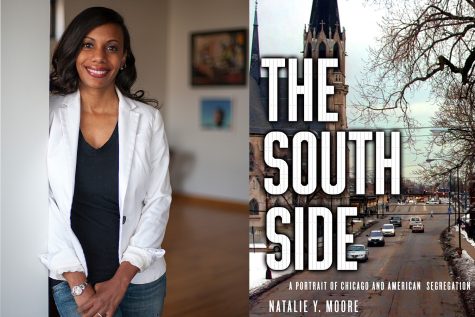‘It’s not happenstance’: 4 years after the release of her book, WBEZ reporter Natalie Moore reflects on segregation in Chicago
November 13, 2020

WBEZ reporter Natalie Y. Moore said she considers herself a “granddaughter of the Great Migration.”
Her maternal grandparents came to Chicago’s Woodlawn neighborhood after World War II, and her father’s side moved north from Nashville, Tennessee, in the early 1900s.
“My grandparents represent the hundreds of thousands of other African Americans who left the South and came to Chicago with little education, but were able to get good jobs. To buy two-flat buildings and send their children to college—even despite the segregation they faced here, that speaks to the resilience that we see in Black communities,” Moore said.
Four years after the release of her award-winning book, “The South Side: A Portrait of Chicago and American Segregation,” Moore explores segregation as a cause of racial inequity and a continuing issue in contemporary Chicago.
The former Columbia journalism adjunct faculty member joined associate professor Sheila Baldwin’s “Issues in African American Studies: Black Migrations” class Nov. 9 for a discussion about her nonfiction book.
“This book was my dissertation for working at WBEZ [since 2007],” Moore said. “Any issue I was covering—whether it was public housing, violence, economic development—all roads were leading back to segregation.”
Through interviews and investigative research, “The South Side” details segregation in Chicago—one of the most segregated cities in the U.S.
According to Census Bureau data, Chicago is relatively equally divided between Black, Latinx and white communities in terms of population, but each lives in separate neighborhoods in the city.
Moore said there are a myriad of underlying causes of segregation among this diverse population: Redlining fenced-off areas—chiefly Black neighborhoods—where banks would not approve loans; restrictive covenants in deeds barred white people from selling or renting to Black people; and, when those laws were struck down and neighborhoods could have integrated, a period of “white flight” saw many white people move to the suburbs.
“We really accept segregation in Chicago and this region as a characteristic that defines us rather than something insidious and something that was planned and designed,” Moore said. “It’s not happenstance.”
Four years after its 2016 release, Moore said the topics in her book are still relevant. She said there has not been intentionality behind efforts to desegregate Chicago for most of the 21st century, but she is excited to see that the younger generation has started to educate themselves on the topic.
If she were to write the book in 2020, Moore said she might have interviewed more current activists, but she also thinks it is important the history she included remains part of the narrative.
One point she would have elaborated on more in her book was the idea of “making it out of the hood,” she said.
She referenced the narrative of “Black excellence,” which she said perpetuates the idea that if one person can break out of the system, everyone else should be able to as well. But Moore said it is crucial to look at segregation as a systemic issue, not an individual fault.
“I wanted to be very clear in my writing that despite all these problems, Black neighborhoods and Black people are not the deficit,” she said. “And I wanted to show the joy of my neighborhood, the joy of my community, the efficacy of my community.”
Portions of “The South Side” were adapted for a production by the 16th Street Theater in 2019. Moore said the theatre commissioned her to write a play that will debut next fall. The play, “The Billboard,” is about reproductive justice in Englewood.
In writing, Moore said it is important to be “authentic.”
“I often get asked, ‘Who is this book for? Who did you write this book for?’” Moore said. “You have to write your truth. You have to write what it is that you feel, and then help people come along for the journey.”







